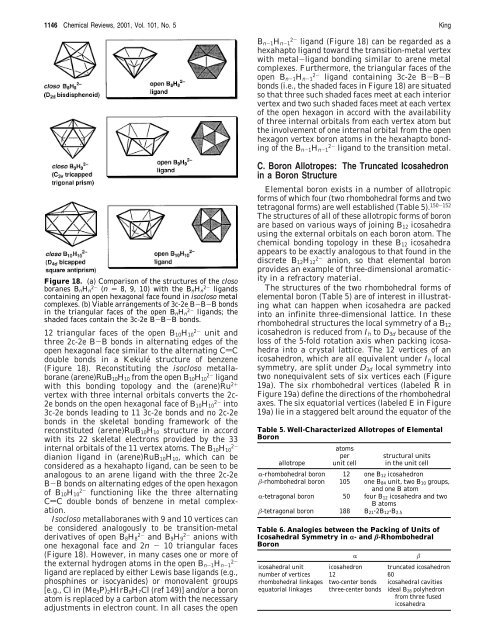Three-Dimensional Aromaticity in Polyhedral Boranes and Related ...
Three-Dimensional Aromaticity in Polyhedral Boranes and Related ...
Three-Dimensional Aromaticity in Polyhedral Boranes and Related ...
Create successful ePaper yourself
Turn your PDF publications into a flip-book with our unique Google optimized e-Paper software.
1146 Chemical Reviews, 2001, Vol. 101, No. 5 K<strong>in</strong>g<br />
Figure 18. (a) Comparison of the structures of the closo<br />
boranes BnHn 2- (n ) 8, 9, 10) with the BnHn 2- lig<strong>and</strong>s<br />
conta<strong>in</strong><strong>in</strong>g an open hexagonal face found <strong>in</strong> isocloso metal<br />
complexes. (b) Viable arrangements of 3c-2e B-B-B bonds<br />
<strong>in</strong> the triangular faces of the open BnHn 2- lig<strong>and</strong>s; the<br />
shaded faces conta<strong>in</strong> the 3c-2e B-B-B bonds.<br />
12 triangular faces of the open B10H10 2- unit <strong>and</strong><br />
three 2c-2e B-B bonds <strong>in</strong> alternat<strong>in</strong>g edges of the<br />
open hexagonal face similar to the alternat<strong>in</strong>g CdC<br />
double bonds <strong>in</strong> a Kekulé structure of benzene<br />
(Figure 18). Reconstitut<strong>in</strong>g the isocloso metallaborane<br />
(arene)RuB10H10 from the open B10H10 2- lig<strong>and</strong><br />
with this bond<strong>in</strong>g topology <strong>and</strong> the (arene)Ru 2+<br />
vertex with three <strong>in</strong>ternal orbitals converts the 2c-<br />
2e bonds on the open hexagonal face of B10H10 2- <strong>in</strong>to<br />
3c-2e bonds lead<strong>in</strong>g to 11 3c-2e bonds <strong>and</strong> no 2c-2e<br />
bonds <strong>in</strong> the skeletal bond<strong>in</strong>g framework of the<br />
reconstituted (arene)RuB10H10 structure <strong>in</strong> accord<br />
with its 22 skeletal electrons provided by the 33<br />
<strong>in</strong>ternal orbitals of the 11 vertex atoms. The B10H10 2dianion<br />
lig<strong>and</strong> <strong>in</strong> (arene)RuB10H10, which can be<br />
considered as a hexahapto lig<strong>and</strong>, can be seen to be<br />
analogous to an arene lig<strong>and</strong> with the three 2c-2e<br />
B-B bonds on alternat<strong>in</strong>g edges of the open hexagon<br />
of B10H10 2- function<strong>in</strong>g like the three alternat<strong>in</strong>g<br />
CdC double bonds of benzene <strong>in</strong> metal complexation.<br />
Isocloso metallaboranes with 9 <strong>and</strong> 10 vertices can<br />
be considered analogously to be transition-metal<br />
derivatives of open B8H8 2- <strong>and</strong> B9H9 2- anions with<br />
one hexagonal face <strong>and</strong> 2n - 10 triangular faces<br />
(Figure 18). However, <strong>in</strong> many cases one or more of<br />
the external hydrogen atoms <strong>in</strong> the open Bn-1Hn-1 2lig<strong>and</strong><br />
are replaced by either Lewis base lig<strong>and</strong>s (e.g.,<br />
phosph<strong>in</strong>es or isocyanides) or monovalent groups<br />
[e.g., Cl <strong>in</strong> (Me3P)2HIrB8H7Cl (ref 149)] <strong>and</strong>/or a boron<br />
atom is replaced by a carbon atom with the necessary<br />
adjustments <strong>in</strong> electron count. In all cases the open<br />
Bn-1Hn-1 2- lig<strong>and</strong> (Figure 18) can be regarded as a<br />
hexahapto lig<strong>and</strong> toward the transition-metal vertex<br />
with metal-lig<strong>and</strong> bond<strong>in</strong>g similar to arene metal<br />
complexes. Furthermore, the triangular faces of the<br />
open Bn-1Hn-1 2- lig<strong>and</strong> conta<strong>in</strong><strong>in</strong>g 3c-2e B-B-B<br />
bonds (i.e., the shaded faces <strong>in</strong> Figure 18) are situated<br />
so that three such shaded faces meet at each <strong>in</strong>terior<br />
vertex <strong>and</strong> two such shaded faces meet at each vertex<br />
of the open hexagon <strong>in</strong> accord with the availability<br />
of three <strong>in</strong>ternal orbitals from each vertex atom but<br />
the <strong>in</strong>volvement of one <strong>in</strong>ternal orbital from the open<br />
hexagon vertex boron atoms <strong>in</strong> the hexahapto bond<strong>in</strong>g<br />
of the Bn-1Hn-1 2- lig<strong>and</strong> to the transition metal.<br />
C. Boron Allotropes: The Truncated Icosahedron<br />
<strong>in</strong> a Boron Structure<br />
Elemental boron exists <strong>in</strong> a number of allotropic<br />
forms of which four (two rhombohedral forms <strong>and</strong> two<br />
tetragonal forms) are well established (Table 5). 150-152<br />
The structures of all of these allotropic forms of boron<br />
are based on various ways of jo<strong>in</strong><strong>in</strong>g B12 icosahedra<br />
us<strong>in</strong>g the external orbitals on each boron atom. The<br />
chemical bond<strong>in</strong>g topology <strong>in</strong> these B12 icosahedra<br />
appears to be exactly analogous to that found <strong>in</strong> the<br />
discrete B12H12 2- anion, so that elemental boron<br />
provides an example of three-dimensional aromaticity<br />
<strong>in</strong> a refractory material.<br />
The structures of the two rhombohedral forms of<br />
elemental boron (Table 5) are of <strong>in</strong>terest <strong>in</strong> illustrat<strong>in</strong>g<br />
what can happen when icosahedra are packed<br />
<strong>in</strong>to an <strong>in</strong>f<strong>in</strong>ite three-dimensional lattice. In these<br />
rhombohedral structures the local symmetry of a B12<br />
icosahedron is reduced from Ih to D3d because of the<br />
loss of the 5-fold rotation axis when pack<strong>in</strong>g icosahedra<br />
<strong>in</strong>to a crystal lattice. The 12 vertices of an<br />
icosahedron, which are all equivalent under Ih local<br />
symmetry, are split under D3d local symmetry <strong>in</strong>to<br />
two nonequivalent sets of six vertices each (Figure<br />
19a). The six rhombohedral vertices (labeled R <strong>in</strong><br />
Figure 19a) def<strong>in</strong>e the directions of the rhombohedral<br />
axes. The six equatorial vertices (labeled E <strong>in</strong> Figure<br />
19a) lie <strong>in</strong> a staggered belt around the equator of the<br />
Table 5. Well-Characterized Allotropes of Elemental<br />
Boron<br />
allotrope<br />
atoms<br />
per<br />
unit cell<br />
structural units<br />
<strong>in</strong> the unit cell<br />
R-rhombohedral boron 12 one B12 icosahedron<br />
-rhombohedral boron 105 one B84 unit, two B10 groups,<br />
<strong>and</strong> one B atom<br />
R-tetragonal boron 50 four B12 icosahedra <strong>and</strong> two<br />
B atoms<br />
-tetragonal boron 188 B21‚2B12‚B2.5<br />
Table 6. Analogies between the Pack<strong>in</strong>g of Units of<br />
Icosahedral Symmetry <strong>in</strong> r- <strong>and</strong> -Rhombohedral<br />
Boron<br />
R <br />
icosahedral unit icosahedron truncated icosahedron<br />
number of vertices 12 60<br />
rhombohedral l<strong>in</strong>kages two-center bonds icosahedral cavities<br />
equatorial l<strong>in</strong>kages three-center bonds ideal B28 polyhedron<br />
from three fused<br />
icosahedra

















